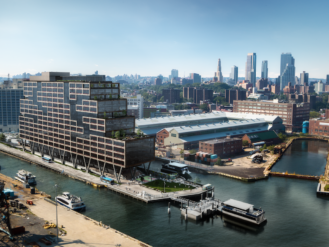Why Eliot Spitzer’s Comeback Starts in Brooklyn
Making bold moves in real estate, the former governor is building a massive apartment complex in Williamsburg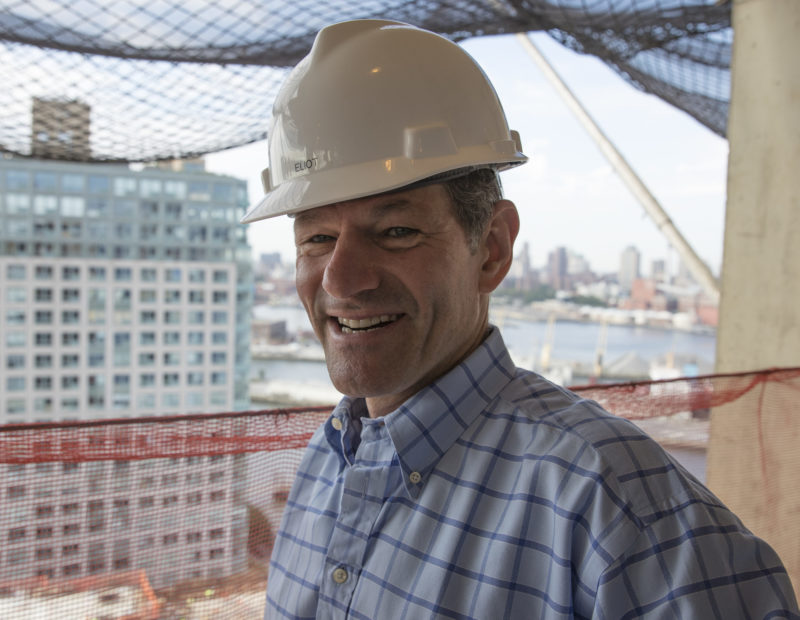
Eliot Spitzer on the construction site of 420 Kent, the residential complex he's building in Williamsburg (Photos by Robert Nickelsberg)
Former New York Governor Eliot Spitzer may be new to the world of Brooklyn real estate, but at this point in his career, little fazes him. “Every sector in New York likes to believe it’s the toughest,” he said, referring to real estate’s reputation for drama and high stakes. “But if you’ve been in politics, if you’ve dealt with the media, if you’ve dealt with real estate, you find that people are people,” he told The Bridge, adding: “As gnarly and edgy people can be in real estate, it’s actually worse in politics. So I was ready for this.”
Politics is in the rearview mirror for Spitzer. What he has been preparing for, instead, is 420 Kent, his first ground-up development as head of Spitzer Enterprises, the real-estate firm his father founded more than five decades ago. 420 Kent marks the biggest project the company has taken on since Eliot joined three years ago, as well as its first ever in Brooklyn. It’s also an ambitious one, situated in the lesser-developed south end of the Williamsburg waterfront. Spitzer’s firm bought the 2.8-acre parcel for $165 million in 2014, then promptly secured a $330 million construction loan to build three 22-story towers. The 857 rental apartments–20% will qualify as affordable housing–will be set amid a complex with a public park, waterfront esplanade and two rooftop pools.
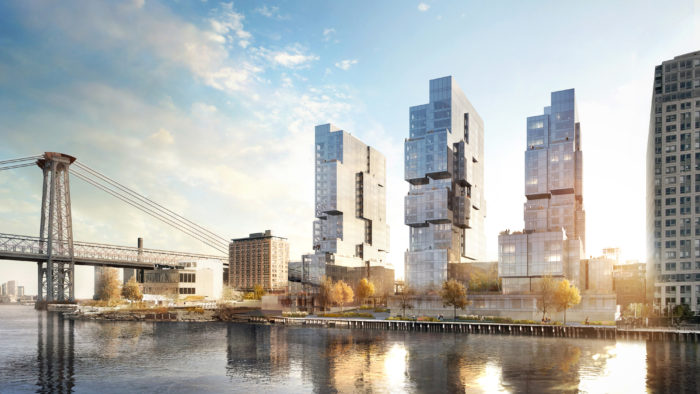
The project’s architect has described it as “a molded iceberg” (Rendering courtesy of ODA)
Becoming a Brooklyn developer was not what Spitzer anticipated, of course, as he raced up the political ladder from Manhattan prosecutor to attorney general of New York and governor in 2007. He had served only 15 months, however, when he resigned amid disclosures that he was a client of a prostitution ring. His return to politics failed in a run for New York City comptroller, as did his short-lived stint as the host of a political talk show on CNN. He was drawn back into the family business in recent years, after his father developed Parkinson’s Disease, then took on its leadership in 2015, after his father’s death.
“The transition isn’t one I would suggest in a career book,” he acknowledged, but he declines to dwell on any struggles he may have faced in moving from the public world of politics to the private sector of real estate. “I loved the government sector,” he said, “But I don’t want anyone to think there was any hesitancy about being where I am now.”
While Spitzer had to give up the public podium, his bold moves in the real-estate world have commanded attention in the industry. In 2015, Spitzer sold his father’s prized possession—a Fifth Avenue landmark, the Crown Building—for $1.78 billion, marking the highest price ever paid, per square foot, for an office building.
Offloading the Crown Building, situated at the intersection of Manhattan’s most expensive real-estate crossroads, allowed him to invest in emerging neighborhoods, like South Williamsburg and Manhattan’s Hudson Yards, where he’s building a 1.4 million sq. ft. residential-and-office development. So while he’s deferential to the company his father built, which primarily invested in prime Manhattan locales, Spitzer is looking to Brooklyn to find his own path in the family business.
“You cannot be static in your analysis of where it is wise to build,” he said, of setting his sights on Kings County. “You have to recognize the organic nature of an urban environment is that neighborhoods change, and it’s important to invest into neighborhoods that are evolving. That’s what we’re doing and will continue to do.”
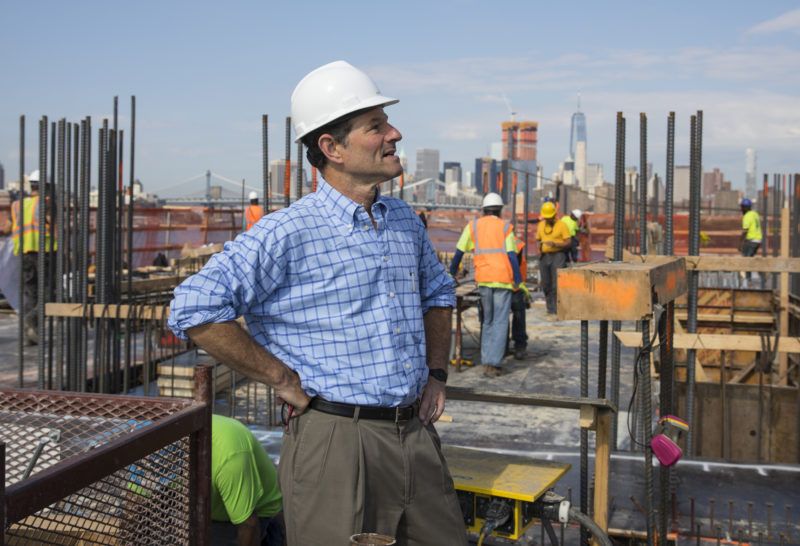
“The transition isn’t one I would suggest in a career book,” said Spitzer
420 Kent, indeed, occupies a portion of the Brooklyn waterfront that has remained relatively quiet in comparison to the explosive development, over the past decade, along the north end. Spitzer and his team are banking on a few related trends to ensure its long-term success: the $3 billion development of the nearby Domino Sugar refinery site into a retail, residential and office hub, the proximity to the NYC Ferry and J and M subway lines (especially after the L shuts down temporarily, in 2019), and also those incredible waterfront views.
All signs point to a major transformation of South Williamsburg, and Spitzer is going to be a significant part of it. “There’s a move [to South Williamsburg] that’s organic, that we will accelerate by building 857 units there,” he said.
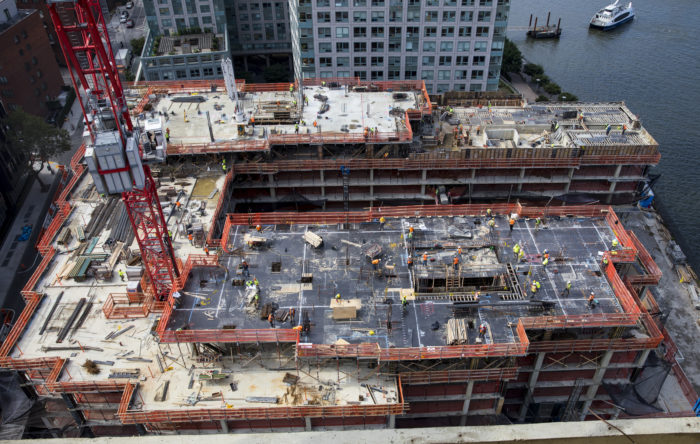
An overhead view of construction underway at 420 Kent
Under his father’s leadership, Spitzer Enterprises was a quietly-run company. And though Spitzer is more of a celebrity than most real-estate moguls, he plans to stay out of the spotlight. (A 2013 Politico report called it “a real estate career in exile,” though the paper also noted that “the ranks of real-estate executives were relatively accepting of Spitzer.”) “At 420 Kent,” said Spitzer, “we’ll be marketing the location, views, quality of the building,” Spitzer said. “We have never used our family name to market anything; that will be the case here as well.”
To handle the more public aspects of 420 Kent, Spitzer assembled a team of Brooklyn industry veterans. The architecture firm ODA is no stranger to high-profile residential projects across the borough. (The firm’s founder, Eran Chen, has referred to the 420 Kent design as “a molded iceberg, sculptured to create the maximum number of views and outdoor spaces.”) David Maundrell, a Brooklyn real-estate entrepreneur who is now at Citi Habitats, will head up marketing and leasing. “Eliot has surrounded himself with a lot of key people who are experts in their field,” Maundrell said. “You wouldn’t guess the guy never built a tower before, considering what’s happening on the construction site.”
Over at the site, the first of the three towers has topped out since construction began last year. Foundation work is underway for the second building, which will connect two towers, and it’s expected to top out by the end of the year. Spitzer expects the first tower will be ready for residents by next summer.
Maundrell portrays Spitzer as heavily involved in the project, from construction to marketing. But why take on such massive projects so early in one’s new career? Spitzer addresses that issue with a question: “Why do something easy if you can do something difficult?”






